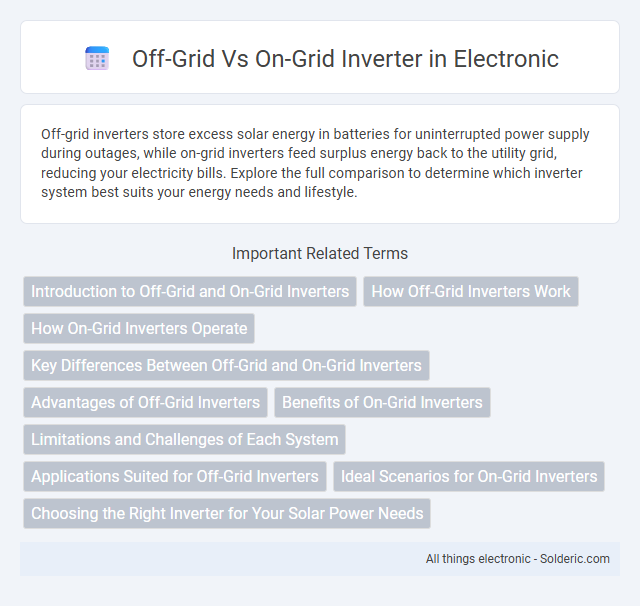Off-grid inverters store excess solar energy in batteries for uninterrupted power supply during outages, while on-grid inverters feed surplus energy back to the utility grid, reducing your electricity bills. Explore the full comparison to determine which inverter system best suits your energy needs and lifestyle.
Comparison Table
| Feature | Off-Grid Inverter | On-Grid Inverter |
|---|---|---|
| Power Source | Battery storage and renewable sources | Utility grid connection |
| Grid Dependency | Independent, no grid needed | Dependent on the grid |
| Energy Storage | Uses batteries for backup | No battery storage required |
| Cost | Higher upfront cost (batteries included) | Lower initial cost |
| Installation | Complex, requires battery setup | Simple grid-tie installation |
| Usage | Remote areas, no grid access | Urban and suburban areas |
| Power Reliability | Reliable with battery backup | Depends on grid stability |
| Grid Export Capability | Not available | Can export excess energy to grid |
Introduction to Off-Grid and On-Grid Inverters
Off-grid inverters operate independently of the utility grid, converting DC power from solar panels or batteries into usable AC power for remote locations without grid access. On-grid inverters synchronize with the utility grid, enabling excess solar energy to be sent back to the grid, often resulting in energy credits or reduced electricity bills. Understanding the differences ensures you select the right inverter for your energy needs and system setup.
How Off-Grid Inverters Work
Off-grid inverters convert DC power from batteries or solar panels into AC power to supply electricity independently from the utility grid, enabling energy storage and usage without grid dependency. These inverters manage battery charging and discharging cycles effectively, ensuring continuous power supply even during solar outages or nighttime. Off-grid systems require precise energy management to balance consumption and generation, making them ideal for remote locations without grid access.
How On-Grid Inverters Operate
On-grid inverters convert direct current (DC) from solar panels into alternating current (AC) synchronized with the utility grid's voltage and frequency. They automatically shut down during grid outages to prevent backfeeding, ensuring safety for utility workers. These inverters feed excess electricity generated back into the grid, enabling net metering and reducing overall energy costs.
Key Differences Between Off-Grid and On-Grid Inverters
Off-grid inverters operate independently from the utility grid, storing energy in batteries to provide power during outages, making them ideal for remote locations without grid access. On-grid inverters synchronize with the utility grid, allowing excess solar energy to be fed back to the grid, reducing your electricity bills through net metering. The key differences lie in their dependency on the grid, energy storage capabilities, and suitability based on your power needs and location.
Advantages of Off-Grid Inverters
Off-grid inverters provide energy independence by storing excess power in batteries, allowing your home to function without reliance on the electrical grid. They enhance energy security during outages and enable use in remote locations where grid access is unavailable. These inverters also optimize renewable energy usage, reducing electricity costs and increasing sustainability.
Benefits of On-Grid Inverters
On-grid inverters efficiently convert solar energy to AC power, allowing you to feed excess electricity back into the utility grid and earn credits through net metering, reducing overall energy costs. These inverters enhance energy reliability by seamlessly synchronizing with grid power, ensuring your home or business enjoys continuous power without the need for large battery storage. Their streamlined design also offers higher efficiency and lower maintenance compared to off-grid systems, making on-grid inverters ideal for maximizing solar investment returns.
Limitations and Challenges of Each System
Off-grid inverters face limitations such as reliance on battery storage, which increases costs and requires regular maintenance, and the challenge of providing consistent power during extended cloudy or low-sun periods. On-grid inverters depend on a stable utility grid connection, making them ineffective during power outages and subject to utility regulations and net metering policies that can limit energy export or financial benefits. Your choice between these systems must consider these challenges, especially regarding energy independence and system reliability.
Applications Suited for Off-Grid Inverters
Off-grid inverters are ideal for remote locations without access to the main power grid, such as cabins, rural homes, and mobile setups like RVs and boats. These inverters support standalone solar power systems, enabling energy independence and reliable electricity storage through batteries. They are also well-suited for emergency backup solutions and off-site construction or agricultural equipment where consistent grid connectivity is unavailable.
Ideal Scenarios for On-Grid Inverters
On-grid inverters are ideal for residential or commercial properties connected to utility grids, where users want to reduce electricity bills by feeding excess solar power back into the grid. These inverters maximize energy efficiency in urban or suburban environments with reliable grid access, enabling net metering benefits. They are suitable for locations with stable infrastructure and frequent sunlight exposure, supporting seamless power transition between solar energy and grid supply.
Choosing the Right Inverter for Your Solar Power Needs
Choosing the right inverter for your solar power system depends on whether you require an off-grid or on-grid setup, each optimized for specific energy needs. Off-grid inverters store excess energy in batteries for use during power outages or remote locations, while on-grid inverters feed surplus electricity back to the utility grid, maximizing energy efficiency and potential savings. Understanding your energy consumption patterns and the availability of a stable grid connection is essential to selecting the inverter that best suits Your solar power goals.
Off-Grid vs On-Grid Inverter Infographic

 solderic.com
solderic.com